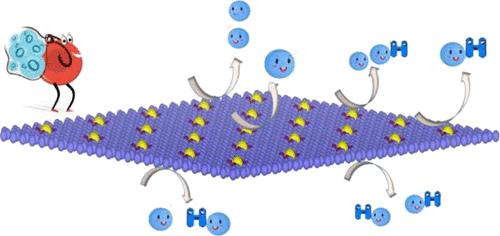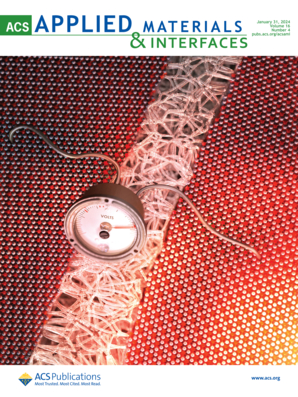单原子催化剂上的常规与非常规氧还原反应中间产物
IF 8.3
2区 材料科学
Q1 MATERIALS SCIENCE, MULTIDISCIPLINARY
引用次数: 0
摘要
氧还原反应(ORR)是电化学中的一个关键过程,在燃料电池、金属-空气电池和氯碱电解槽等各种能量转换技术中都有应用。因此,以氮掺杂石墨烯(NG)支撑的单原子催化剂(SACs)为模型体系,对提出的传统和非常规ORR机制进行了全面的密度泛函理论(DFT)研究。在*OOH, *O和*OH中间体之后,已经确定了几种反应中间体,它们似乎比传统机制中假设的中间体更稳定。这一发现尤其适用于吸附的*O2,它可以具有不同的吸附几何形状,从η1Ο2或η2Ο2超氧配合物以及sin和anti配合物,两个o相关的配体分别结合在相同或相反的两侧。对于M@NG (M = Sc, Ti, V, Cr, Mn, Fe, Co, Ni, Cu, Zn和Pt), ORR遵循这些非常规*O2中间体,而对于Cr@NG和Cu@NG,经典和非常规*O2中间体竞争。我们使用热力学过电位的概念来近似电催化活性,并证明在质子耦合电子转移的四个步骤中,与非常规中间体的机制相比,传统机制产生的过电位更小。我们的趋势研究表明,由于热力学过电位较大,d电子较少的过渡金属表现出较小的电催化活性。在所研究的SAC体系中,Co的热力学过电位和极限电位相对于标准氢电极分别为0.38 V和0.85 V,是一个很有前途的候选体系,传统机制更受青睐,Cu则是次优的候选机制。本文章由计算机程序翻译,如有差异,请以英文原文为准。

Conventional versus Unconventional Oxygen Reduction Reaction Intermediates on Single Atom Catalysts
The oxygen reduction reaction (ORR) stands as a pivotal process in electrochemistry, finding applications in various energy conversion technologies such as fuel cells, metal-air batteries, and chlor-alkali electrolyzers. Hereby, a comprehensive density functional theory (DFT) investigation is presented into the proposed conventional and unconventional ORR mechanisms using single-atom catalysts (SACs) supported on nitrogen-doped graphene (NG) as model systems. Several reaction intermediates have been identified that appear to be more stable than the ones postulated in the conventional mechanism, which follows the *OOH, *O, and *OH intermediates. This finding particularly holds for adsorbed *O2, which can have different adsorption geometries, ranging from η1Ο2 or η2Ο2 superoxo complexes as well as sin and anti complexes, with the two O-related ligands binding on the same or opposite sides, respectively. In the case of M@NG (M = Sc, Ti, V, Cr, Mn, Fe, Co, Ni, Cu, Zn, and Pt), the ORR follows these unconventional *O2 intermediates, whereas for Cr@NG and Cu@NG classical and unconventional *O2 intermediates compete. We approximate the electrocatalytic activity using the concept of the thermodynamic overpotential and demonstrate that the conventional mechanism gives rise to a smaller overpotential compared to mechanisms following unconventional intermediates during the four proton-coupled electron transfer steps. Our trend study indicates that transition metals with fewer d electrons reveal smaller electrocatalytic activity due to a larger thermodynamic overpotential. Among the investigated SAC systems, Co emerges as a promising candidate, with thermodynamic overpotential and limiting potential values of 0.38 and 0.85 V vs the standard hydrogen electrode, respectively, with the conventional mechanism being favored, and with Cu appearing as the second-best candidate.
求助全文
通过发布文献求助,成功后即可免费获取论文全文。
去求助
来源期刊

ACS Applied Materials & Interfaces
工程技术-材料科学:综合
CiteScore
16.00
自引率
6.30%
发文量
4978
审稿时长
1.8 months
期刊介绍:
ACS Applied Materials & Interfaces is a leading interdisciplinary journal that brings together chemists, engineers, physicists, and biologists to explore the development and utilization of newly-discovered materials and interfacial processes for specific applications. Our journal has experienced remarkable growth since its establishment in 2009, both in terms of the number of articles published and the impact of the research showcased. We are proud to foster a truly global community, with the majority of published articles originating from outside the United States, reflecting the rapid growth of applied research worldwide.
 求助内容:
求助内容: 应助结果提醒方式:
应助结果提醒方式:


